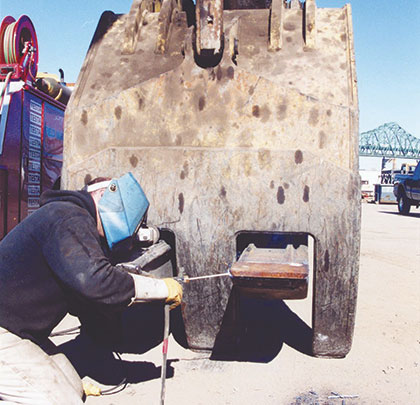When welding abrasion-resistant (AR) plate to a piece of equipment, it is important to select the most appropriate filler metal for the application—whether it’s a matter of repair or the fabrication of a new plate onto a structure.
AR plates have an incredibly high hardness and are designed to provide long service life in harsh conditions. For this reason, AR plates are common on critical equipment components frequently involved in impact and/or sliding contact with abrasive materials. For example, AR plate can be found on backhoe buckets and teeth, bulldozer blades, dump truck beds, and more as protection from excessive wear.
AR plates come in a variety of sizes—both lengths and widths—and range in thickness from ½ to more than 2 inches. AR plate product numbers range from 200 to 500 and typically indicate the hardness of the material: AR200, AR400, or AR500 are examples. In the case of AR400, the plate’s hardness would equal about 42 Rockwell C (HRC) or approximately 400 on the Brinell Hardness scale, while AR500’s hardness would be around 50 HRC or roughly 500 on the Brinell Hardness scale. Typically, the harder the material, the more resistant it will be to abrasive wear.
Welding AR plate to itself or any structure with dissimilar and softer or lower-strength steel poses particular challenges, the biggest of which is preventing cracking in the weld metal or heat-affected zone (HAZ) of the AR plate. Rapid cooling, highly restrained joints, and/or excessive hydrogen in the weld metal or filler metals are among the biggest culprits of cracking. To help, below are seven tips to help maximize quality when welding AR plates.
TIP NO. 1:
Pre-heat the base material. Pre-heating the base material is one way to prevent rapid cooling, reduce hydrogen levels, and prevent cracking. Welding operators should always follow pre-heating recommendations for the base material to which the AR plate is being welded.
TIP NO. 2:
Take the joint and weld designs into consideration. Whenever possible, do not locate the weld joint in a highly restrained area that constricts the base material, AR plate, or weldment from expanding and contracting freely. Also, by welding shorter, smaller fillet welds, welding operators can reduce the heat input and overall residual stresses on the AR plate.
TIP NO. 3:
Choose the right filler metal. Filler metal selection should be based on the tensile strength of the base metal to which the AR plate will be welded. A filler metal with the least amount of hydrogen content and the lowest tensile strength that still provides a high enough impact value can help welding operators combat the potential for cracking. As always, operators should check AR plate manufacturer recommendations, based on the grade of base metal, before making a final filler metal selection.
TIP NO. 4:
Consider using a low-hydrogen stick electrode in the field. When repairing or replacing an AR plate equipment that has been in service, a low-hydrogen stick electrode with a basic slag system, such as an American Welding Society (AWS) E7018 product, works well. This stick electrode can deliver exceptional as-welded mechanical properties and toughness properties, and also offer high resistance to hydrogen pickup. In addition, it can weld through contaminants such as mud, rust, dirt, and oil, which tend to accumulate on used equipment. Since stick electrodes are portable, lightweight, and do not require shielding gas, they are ideal for field repairs. A few downsides to note: Stick electrodes can be inefficient for large AR plate repairs; they may lower quality bead appearance; they require frequent electrode changes; and the slag they produce must be removed between passes and after welding.
TIP NO. 5:
Gain benefits from flux-cored wires. Gas-shielded flux-cored wire is often recommended for AR plate welding because of its toughness, high resistance to hydrogen pickup, and ability to weld through light rust and mill scale. For this reason, gas-shielded flux-cored wire offers the greatest versatility for welding AR plate to heavy equipment, whether for fabrication or repair work. Self-shielded (gasless) flux-cored wire, like stick electrodes, does not require shielding gas, which makes it a good choice for repairing AR plates in an outdoor setting. Although self-shielded flux-cored wire eliminates the need to haul gas tanks into the field, it can increase the potential for cracking due to a lack of impact properties. Contact a trusted filler metal manufacturer for the best recommendation. Also note: Both types of flux-cored wires produce slag that must be removed in between passes and after welding.
TIP NO. 6:
Use solid wire indoors on new equipment. When welding AR plates onto new, clean heavy equipment structures in an indoor setting, a solid wire, such as an AWS ER70S-3 or ER70S-6, works well—especially if the base material is A36. Solid wire does not require slag removal and offers a nice bead appearance.
TIP NO. 7:
Use metal-cored wire to improve productivity and quality. Metal-cored wire can increase travel speeds and thereby minimize heat input that may otherwise lead to rapid cooling and, ultimately, cracking when welding AR plate. Most metal-cored wire offers excellent toughness properties, creates little to no spatter, and performs well on clean base materials, as well as those with light mill scale or rust. When there is a poor fit-up between the AR plate and base material, metal-cored wire is better suited to bridge the gap than other filler metals due to its cone-shaped arc. It also offers higher deposition rates than solid wires, which can help increase production.
About the Author:
Caleb Haven is a welding engineer, applications group, with Hobart. For more information about Hobart products, visit www.hobartbrothers.com.
_________________________________________________________________________
Modern Contractor Solutions – September 2016
Did you enjoy this article?
Subscribe to the FREE Digital Edition of Modern Contractor Solutions magazine.



